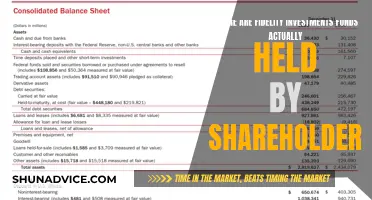
Investing in mutual funds is just the first step. To make informed decisions about your investments, it's crucial to periodically check on their performance and health. This is where folio numbers and fund fact sheets come in. A folio number is a unique code assigned to each investor by the mutual fund company, similar to a bank account number. It helps monitor your investments and keeps track of your transactions. You can use this number to check the status of your mutual fund investments through websites, mobile apps, or by contacting the fund office directly. Additionally, fund fact sheets are published monthly and provide an overview of the fund's performance, portfolio allocation, and relevant financial data. These simple and concise documents are designed to be easily understood by the average investor. By utilising folio numbers and fund fact sheets, you can stay informed about your mutual fund investments and make more confident decisions.
| Characteristics | Values |
|---|---|
| Unique ID | Folio number |
| Folio number function | Works like an account number |
| How to get a folio number | The folio number is given by the mutual fund company |
| Where to find the folio number | Consolidated Account Statement (CAS) sent by the AMC, Mutual Fund Statements for SIPs, lump-sum investments, or redemptions, by calling the AMC or visiting their office in person |
| How to check mutual fund status | Registrar Website, AMC Website, Brokerages, Consolidated Account Statement (CAS), AMC Office Visit, AMC's Customer Care, Financial Advisor |
| How to locate folio number online | Visit camsonline.com, click on 'MF Investors', choose 'CAS-CAMS' under the 'Statements' menu, enter the email address, PAN, and select the fund house |
| How to access CAS | Password-protected file sent to the investor's email address |
| How to check mutual fund status online | AMC Websites and Mobile Apps, Online Portfolio Trackers, Mutual Fund Fact Sheets, Investment Advisor |
| How to check mutual fund status offline | AMC Office Visit, Registrar Website |
What You'll Learn

Understanding folio numbers
Folio numbers are an essential component of mutual fund investments. They are unique identification numbers assigned to individual investor accounts by Asset Management Companies (AMCs) when investing in a mutual fund. These numbers help investors track their assets and transactions in a specific scheme. Understanding folio numbers is crucial for investors to effectively manage and monitor their investments.
A folio number is a unique identifier, similar to a bank account number, that is assigned to an investor when they first invest in a mutual fund scheme. This number is linked to the investor's Permanent Account Number (PAN) and is essential for Know Your Customer (KYC) verification during the investment process. The folio number remains the same for all subsequent investments made by the investor in the same plan.
Folio numbers can be numeric or alphanumeric, a mix of letters and digits. They are crucial for keeping track of investments with different AMCs, as each investment with a different AMC will have its folio number linked to the investor's PAN.
Advantages of Folio Numbers
Folio numbers offer several benefits to investors:
- Effortless tracking: Folio numbers allow investors to easily monitor their funds across various plans and schemes.
- Comprehensive history: Investors can access detailed transaction histories and mutual fund account statements using their folio numbers.
- Simplified KYC: The folio number is linked to the investor's PAN, eliminating the need for repetitive KYC procedures with the same fund house.
- Time savings: With a single folio number, investors can avoid the hassle of managing multiple account numbers.
- Enhanced authenticity: Folio numbers assist AMCs in verifying the authenticity of the unit holder.
Locating Your Folio Number
It is important to know where to find your folio number for a particular AMC. Here are a few ways to locate it:
- Consolidated Account Statement (CAS): The folio number is typically found in the top corner of the CAS, which is provided periodically by the AMC.
- Mutual fund account statement: If you transact through SIPs or lump-sum investments, the mutual fund account statement will also display the folio number.
- Contacting AMC or RTA (Registrar and Transfer Agent): You can call the toll-free number or send an email to the AMC to inquire about your folio number.
- Visiting the AMC office: You can visit the office of the AMC and request to retrieve your folio number.
Checking Mutual Fund Status with Folio Number
Folio numbers are crucial for checking the status of your mutual fund investments. Here are some ways to do so:
- Online tracking: Log in to the website or app of the AMC and use your folio number to access details about your mutual fund balance, transaction history, and more.
- Registrar's website: Register on registrar websites using your PAN and mobile number to access information about your mutual fund status.
- Contact your broker: If you invested through a broker, contact them for updates on your mutual fund status. Brokers can provide real-time information about your investments.
- AMC customer care: Visit the AMC's office or contact their customer care to provide your folio number and PAN for verification. They will then provide details about your holdings.
- Consolidated Account Statement: Depositories like CDSL and NSDL send consolidated account statements that include folio-wise mutual fund performance details.
Index Funds: Understanding Their Typical Investment Strategies
You may want to see also

Consolidated Account Statement (CAS)
A Consolidated Account Statement (CAS) is a useful way to keep track of your mutual fund investments. It is a consolidated statement that contains details of all the financial transactions performed in a month under the same PAN across fund houses and accounts/folios. You can receive a CAS from CDSL (Central Depository Services Limited) or NSDL (National Securities Depository Limited) for months when there has been a financial transaction in your mutual fund portfolio.
The CAS will be sent to your registered email or mailing address. You can also access the statement online by visiting the official CAMS website. Here are the steps to do so:
- Visit camsonline.com and click on 'MF Investors'.
- On the following page, choose 'CAS-CAMS' under the 'Statements' menu.
- Enter the email address registered in your mutual fund folio, your PAN, and select the fund house.
- You can also choose a specific folio listing and the period for which you want the CAS statement.
- Choose a password that you'll use to access the CAS you receive on your email address.
- You'll receive the CAS on your email address in a password-protected file.
- Enter the same password from the above step to access your CAS.
You can also view and download your mutual fund Portfolio & CAS on the portal of MFCentral, a collaborative online services hub launched jointly by KFintech & CAMS. Here, you can choose to generate a 'Summary CAS' or a 'Detailed' CAS, and can choose the desired period, such as the current financial year, previous financial year, or a specific period (not more than 365 days).
Diversification: A Key Advantage of Mutual Fund Investments
You may want to see also

AMC Website/Mobile App
Most Asset Management Companies (AMCs) now allow investors to access their mutual fund schemes online, either through their website or mobile app. If you've used the digital route for investing, you can log in to your account on the AMC's website or mobile app to view the account statement and analyse portfolio performance. This is especially useful for tracking investments in months when no transactions have taken place, as Consolidated Account Statements (CAS) are only generated for months in which a financial transaction is performed.
To access your account, you will need your folio number and possibly your PAN number for verification. Your folio number is a unique identification number assigned by an AMC when you invest in a mutual fund, and it is linked to your PAN. It is also possible to retrieve your folio number by entering your PAN and other personal details on the AMC's website.
Mutual Fund Investment: Current Smart Choices
You may want to see also

Online portfolio trackers
- Sharesight: Sharesight allows you to track the performance of your investments using data from 60 global stock exchanges. It can monitor stocks, ETFs, mutual funds, cryptocurrencies, real estate, private equity, and fixed-income investments. Sharesight offers a free service for up to ten holdings or one portfolio, with premium plans starting at $7 per month.
- Snowball Analytics: Snowball Analytics is suitable for beginners and professionals, offering in-depth dividend reporting and analysis, performance tracking, and the ability to connect with over 1,000 brokers worldwide.
- Kubera: Kubera claims to be the world's most modern portfolio tracker, allowing you to track all your assets, both traditional and crypto, in one place. You can connect your online brokerage accounts, add individual stocks, and track their real-time value. Kubera costs $15 per month or $150 per year.
- Magnifi: Magnifi is a marketplace that provides common brokerage tools and AI to help you make informed investment decisions. It offers commission-free investing, a mobile app, and over 15,000 possible investment options.
- InvestorsObserver: InvestorsObserver provides a comprehensive view of all your brokerage accounts in one place, along with personalized analysis of your holdings. It offers unlimited stock watchlists and alerts, a stock comparison tool, and an app for iOS and Android.
- Personal Capital (now Empower): Empower is a popular choice, offering an all-inclusive snapshot of your finances by tracking your portfolios, bills, bank accounts, and credit card statements. It can sync with various investment and bank accounts and provides easy-to-read graphs and charts. Empower is free to use on iOS, Android, and desktop.
- Stock Rover: Stock Rover provides access to a wide range of assets, including stocks, ETFs, and mutual funds, and offers powerful portfolio analysis tools. It has a free version and a paid subscription with additional features.
- Delta Investment Tracker: Delta is an iOS and Android app with a minimalistic design and a "dark mode" option. It provides live access to price movements of various assets, including stocks, cryptocurrencies, ETFs, mutual funds, and bonds. Delta offers a clear overview of your total portfolio balance and profit and loss over different periods.
- Ziggma: Ziggma combines portfolio insights with technology-enabled stock research. It offers a unique dashboard that provides a 360-degree view of your portfolio, allowing you to consolidate unlimited investment accounts. Ziggma has a free version and a premium subscription starting at $7.50 per month.
- Fidelity Full View: Fidelity Full View, powered by eMoneyAdvisor, enables you to track your portfolio's performance, asset allocation, and net worth. However, it may not offer the same level of reporting as the full eMoneyAdvisor platform.
Strategies for Picking a Hedge Fund to Invest In
You may want to see also

Mutual Fund Fact Sheet
A mutual fund fact sheet is a basic document that gives an overview of a mutual fund. It is a simple and accessible tool for investors to stay informed about a fund's essential details. These fact sheets are typically updated monthly and can be easily found on the fund's platform as a PDF.
- Fund name and what it does: The full name of the fund, its type (e.g., equity, bond, hybrid), and the fund manager. It also includes the fund's investment strategy and objective, such as whether it aims for capital appreciation, income, or both.
- Performance data: The fund's historical performance over various time frames, from one month to 10 years or more, is often compared against a relevant benchmark index.
- Fund composition: Details on the composition of the fund's portfolio, including the percentages of different asset classes (e.g., stocks, bonds), sectors (technology, healthcare), or geographic regions.
- Top holdings: The top 10 holdings that most affect the fund, which is important for managing risk.
- Risk profile: Metrics such as the fund's volatility, measured by standard deviation, or other risk assessments to indicate the level of risk.
- Fees and expenses: Information on the costs associated with the fund, as high fees can significantly impact overall returns.
- Minimum investment requirements: Details about the minimum investment amounts for initial and subsequent investments.
- Dividend information: For income-focused funds, information about dividend yields, payout frequency, and historical dividend distributions.
- Manager commentary: Additional insights from the fund manager about recent performance, changes in holdings or strategies, and the outlook based on current market conditions.
- Glossary and additional information: A glossary of key terms and any important caveats or disclosures about the statements provided.
Fact sheets are a great starting point for investors to evaluate a mutual fund and understand its benefits and risks. They provide concise and easily digestible information, allowing even new investors to get up to date on a fund's key facts.
Mutual Fund Investment Strategies: Where to Invest?
You may want to see also
Frequently asked questions
A folio number is a unique code given to you by the mutual fund company. It works like an account number, making it easier to monitor your investment.
You can find your folio number in the top corner of the Consolidated Account Statement (CAS) sent periodically by the AMC. Mutual Fund Statements for SIPs, lump-sum investments, or redemptions also contain the folio number.
There are several ways to check your mutual fund status, including:
- Registrar Website: Websites like CAMS or Karvy let you check your fund status by entering your PAN, folio number, and mobile number.
- AMC Website: Sign in to the AMC's website and go to the mutual fund status section to see your investments.
- Consolidated Account Statement (CAS): Get summaries of your mutual funds if you have a Demat account, sent through email by CDSL or NSDL.







